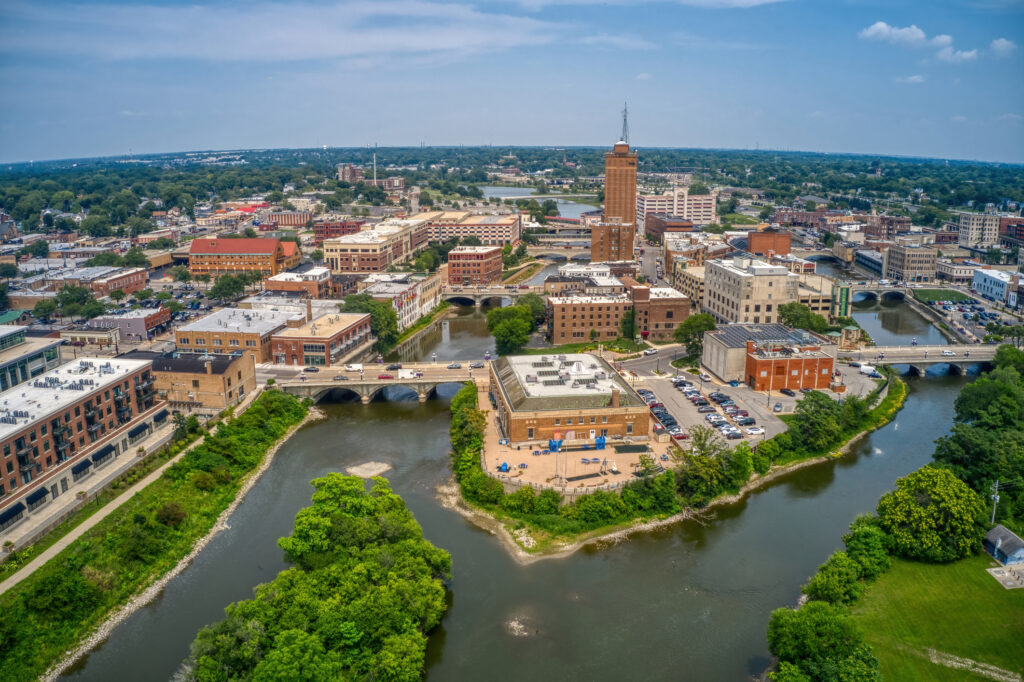
Aurora, IL is Using the International Existing Building Code to Rehab Buildings That Were Vacant for 30 Years
Aurora, IL Building Official John Curley uses IEBC to save owners hundreds of thousands of dollars while breathing new life into existing buildings.
The International Existing Building Code® (IEBC) is readily available to building departments and municipalities that are looking to use and reuse existing offices, hospitals, apartments and other structures. However, many building officials have grown accustomed to using the International Building Code® (IBC) and International Residential Code® (IRC) and may not realize the advantages, including the potential cost savings, that the IEBC provides.
John Curley, Chief Development Services Officer for the Development Services Department of the City of Aurora, IL, has adopted and successfully used the IEBC to breathe new life into the city’s main street buildings. Curley regularly takes the time to educate both designers and owners about the code and how it could be leveraged for their rehabilitation projects.
“We’ve had owners walk away from those meetings saying, ‘Hey, I think you just saved us a quarter of a million dollars,’” said Curley. “Without the IEBC, that project would not have occurred. That’s probably true for half a dozen main street buildings in our downtown.”
See Related: Architects Used the International Existing Building Code to Bring Michigan Central Back to its Former Glory
The International Existing Building Code in Action
One of the city’s flagship projects includes the Aurora Silverplate Building. With just three stories at 1,350 square feet per floor, Silverplate was a very small building that sat vacant for 30 years. No one could figure out a use, and more importantly, a way to rehab Silverplate in a way that made fiscal sense for the investment. Curley said that its teardown would have been detrimental to the main corner on Stolp Island, the heart of his area’s downtown.

Everyone who approached the building thought it needed fire suppression (sprinklers) and a second exit. This, Curley said, is because they were approaching the code compliance puzzle solely from the new code path established by the IBC and the International Fire Code® (IFC).
Using the IEBC’s Performance Compliance Method, which provides an objective scoring system that allows owners and designers to add and subtract points to meet compliance, Curley proved those upgrades weren’t necessary. Silverplate had been built with a higher construction type than what was actually required for a building its size.
Its small stature also meant that the travel distances were very short, allowing people to exit quickly in the event of an emergency. This meant that Silverplate was inherently safer than a potentially much larger new IBC/IFC-compliant building that contained modern safety features but was built with lesser-grade fire resistance materials, without fire compartments and with a less robust smoke detection system.
“We have three units and a thriving ice cream shop on the first floor [because of the IEBC],” said Curley. “They’re developing a little speakeasy in the basement as well.”
See Related: Reviving History: Transforming Buildings with the International Existing Building Code
Getting More Out of Your Buildings With the International Existing Building Code
Curley has found that the Performance Method is particularly beneficial for two- and three-story main street buildings.
For example, in the case of Silverplate, the building was penalized for not having a sprinkler system. With the building department’s help, the designer was able to make up for this by adding a two-hour separation between the first and second floors. This doubled the amount of time that the floor could withstand a fire before it spread. They also created two-hour stair compartments. The code only requires one-hour separation and one-hour compartments. By going above minimum IBC/IFC code compliance for these aspects, the building received additional credits that would mitigate the penalty incurred for not having a sprinkler system.
The Performance Method also allows designers to overcome the need for sprinklers by increasing the smoke alarm system beyond the minimum code requirements. In Curley’s area, many of the small residential use cases require a single-stage alarm that only notifies the occupants when smoke is detected. These buildings may not even require an alarm in every room. But by adding detection in more places, or by adding an alarm that alerts the fire department when there’s a problem, the building can exceed code minimum compliance for fire alarms and fire detection. Curley said that in some cases, this can allow a building to pass the objective safety analysis even without fire suppression.
Curley sees this as a win-win benefit. “The faster your detection happens, the faster we provide emergency response rolling to the scene, the faster occupants can react to the situation if they have to egress,” he said. “It’s a prudent trade-off financially because most of these buildings don’t have compliant alarms to begin with, so you already had to upgrade the alarm. If over-improving some features can offset the need for a suppression system, some marginally feasible projects can be made feasible and more of your underutilized main street building stock can find new life.”
The International Existing Building Code Provides a Chance to Team Up With Code Officials
In addition to the Performance Method, the IEBC offers two other methods, Prescriptive and Work Area, that afford owners and designers a degree of flexibility in how they proceed. Curley said that the Prescriptive Method is effective for buildings that don’t require significant changes. He said the Work Area Method has three alteration levels that attempt to make the building code response commensurate with the amount of work that needs to be performed during the rehab. While he has had great success with the Performance Method, he likes to use Alteration Level 1 for the Work Area Method when dealing with modifications that are a bit more modest.
Curley advised owners and designers to avoid making code compliance decisions about their rehab projects before approaching a code official. He is concerned that effective solutions, including those that could save the owner money, would be lost if the owner or designer attempts to firm up their plans without considering other paths to code compliance. Curley recommends that they “ascertain the level of flexibility the municipality has encouraged their compliance staff to utilize” before moving forward.
“We set up a separate permit type and we tell design professionals, ‘Get your schematic design done,’” said Curley. “Then we can sit down and talk about how to leverage the IEBC before they make a lot of commitments to their clients. In the end, it’s really difficult for design professionals to step backward from their code compliance assumptions shared with their client up front. But they should understand that we’re anxious to use these tools to make our buildings easier to redevelop, more feasible for redevelopment, and with more predictable compliance requirements.”
Aside from encouraging Aurora building owners and designers to use the IEBC, Curley also wants building officials to know why they should explore the benefits of this code in their own jurisdictions.
“The way the codes are set up, a town that does not adopt the IEBC and is solely using the IBC is cutting out some of the front-end sections that are only in the IEBC,” said Curley. “If they do that without modifying the IBC (to add these front-end sections), they’ll run counter to the way codes were developed. You’re entitled to do it that way if you want to. But the IEBC was designed to be adopted in tandem with the IBC and the IFC. The IEBC is the designated and intended starting point for remodeling projects.”
To learn more about the Code Council’s International Existing Building Code, click here.






